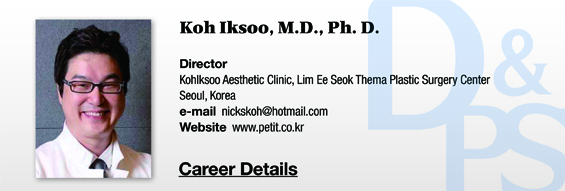.jpg)
Figure 1. New tissue regrowth into dermal filler.
After much consideration about what could cause such a difference in duration among treatment areas, I concluded that the pressure may play a role. Dermal filler injected in the pretarsal mound is placed stably in soft tissues. Muscle movement in this area does not affect the shape of the filler. On the other hand, the chin has strong muscles that may pull on the injected filler.
As the filler overlaps with the muscles, it is subject to the strong muscular movement. For frontal chin, the filler should be molded in the opposite direction of the tough skin and muscles, which causes physical instability. For these reasons, filler treatments of the frontal chin are relatively short-lived than pretarsal augmentation.
New Tissue Regeneration vs. Tissue Response
If the filler is maintained for 1-2 years after treatment, does it mean filler ingredients are still remaining? This is tricky, as new tissues can gradually replace the filler and maintain the shape. This is sometimes referred to as new tissue regeneration effect and often occurs in areas of soft tissues and low pressure, such as the cheek, and dark circle, etc. New tissues grow into the filler material and replace it after it has been absorbed.
This effect is more likely when the filler is injected into a drop-like shape as it makes the infiltration of new tissues easier. However, the initial shape created by the filler is not fully maintained through this effect as new tissues do not replace the filler completely. The regeneration effect is harmless and patients are satisfied with the long-lasting effect of the treatment. However, there is one thing that requires caution.
A tissue response that recognizes the filler as a foreign intrusion tends to appear similar to tissue regeneration at first. When new tissues replace the filler, not 100 percent of the initial shape is maintained. On the other hand, the tissue response tends to maintain the initial shape very well, in which case one needs to be suspicious.
[Advertisement] MAGNUM(Q-switched Nd:YAG Laser) – Manufacturer: (www.i-dana.com)]
Great caution is needed with areas where the filler is maintained longer and degrades more slowly. As for permanent fillers, only use products that have established safety profiles including a low risk of tissue response. During the first year after treatment, tissues do not recognize the filler as an antigen and develop granuloma but the risk grows 3-5 years after treatment.
Instead of focusing on developing products with strong cross-linking for better resistance to enzymes, dermal filler manufacturers should research safe fillers that do not cause tissue response in the long-term.
-To be continued





















